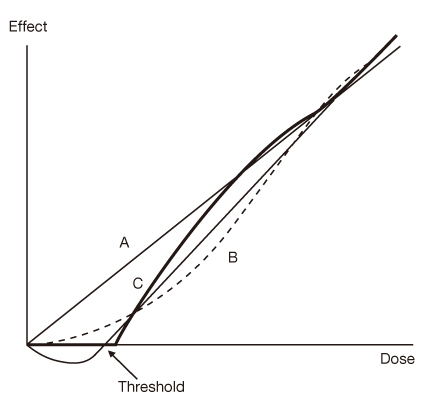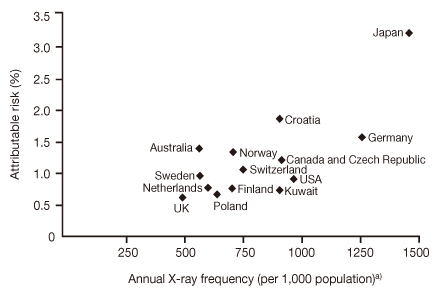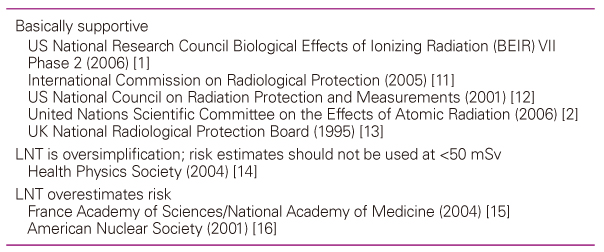 |
 |
- Search
| J Korean Med Assoc > Volume 54(12); 2011 > Article |
Abstract
Low dose radiation has been defined as doses in the range under 100 mSv of low linear energy transfer (low-LET) radiation. There are two sources of ionizing radiation: natural and artificial radiation. Medical radiation exposure is the most common artificial radiation exposure. The frequency and volume of medical radiation exposure has markedly increased because of recent developments in medical technology. Radiation protection is now a concern due to the increasing use of computed tomography (CT) scans and diagnostic X-rays. This article introduced several models and hypotheses regarding the possible carcinogenic risks associated with low-LET radiation. Although opinions vary on the health effects of low level radiation exposure, current studies of medical radiation rely on exposure information collected prospectively, including cohort studies such as atomic bomb survivor studies. Although there are differences in perspective, the majority of studies have supported 'linear-no-threshold model without threshold' between low-LET radiation and the incidence of cancer risk. There is a need for further studies on medical radiation exposure including CT and positron emission tomography in order to understand the health effects of low-LET radiation, including the cancer incidence.
References
1. National Research Council (US). Committee to Assess Health Risks from Exposure to Low Levels of Ionizing Radiation. Health risks from exposure to low levels of ionizing radiation: BEIR VII phase 2 2006;Washington DC: National Academies Press.
2. United Nations Scientific Committee on the Effects of Atomic Radiation. Effect of ionizing radiation: UNSCEAR 2006 report to the general assembly with scientific annexes 2006;Vienna: United Nations.
3. International Agency for Research on Cancer. IARC monographs on the evaluation of carcinogenic risks to humans. Ionizing radiation: part 1. X- and gamma-radiation and neutrons 2000;Lyon: International Agency for Research on Cancer.
4. Preston DL, Ron E, Tokuoka S, Funamoto S, Nishi N, Soda M, Mabuchi K, Kodama K. Solid cancer incidence in atomic bomb survivors: 1958-1998. Radiat Res 2007;168:1-64.
5. Bennett B, Repacholi M, Carr Z. World Health Organization. Health effects of the Chernobyl accident and special health care programmes 2006;Geneva: World Health Organization.
6. Greenpiece International. The Chernobyl catastrophe: consequences on human health 2006;Amsterdam: Greenpiece.
7. Czeizel AE. Incidence of legal abortions and congenital abnormalities in Hungary. Biomed Pharmacother 1991;45:249-254.
8. Knudsen LB. Legally induced abortions in Denmark after Chernobyl. Biomed Pharmacother 1991;45:229-231.
9. Odlind V, Ericson A. Incidence of legal abortion in Sweden after the Chernobyl accident. Biomed Pharmacother 1991;45:225-228.
10. Einstein AJ, Henzlova MJ, Rajagopalan S. Estimating risk of cancer associated with radiation exposure from 64-slice computed tomography coronary angiography. JAMA 2007;298:317-323.
11. Valentin J. Low-dose extrapolation of radiation-related cancer risk. Ann ICRP 2005;35:1-140.
12. National Council on Radiation Protection and Measurements. Evaluation of the linear-nonthreshold dose-response model for ionizing radiation 2001;Bethesda (MD): National Council on Radiation Protection and Measurements.
13. National Radiological Protection Board. Risk of radiation-induced cancer at low doses and low dose rates for radiation protection purposes 1995;Chilton: National Radiological Protection Board.
14. Radiation risk in perspective: position statement of the Health Physics Society [Internet] 2004;cited 2011 Nov 18. McLean (VA): Health Physics Society. Available from: http://hps.org/documents/radiationrisk.pdf
15. Tubiana M. Dose-effect relationship and estimation of the carcinogenic effects of low doses of ionizing radiation: the joint report of the Academie des Sciences (Paris) and of the Academie Nationale de Medecine. Int J Radiat Oncol Biol Phys 2005;63:317-319.
16. Health effects of low-level radiation: position statement [Internet] 2001;cited 2011 Nov 18. La Grange Park (IL): American Nuclear Society. Available from: http://www.ans.org/pi/ps/docs/ps41.pdf
17. United Nations Scientific Committee on the Effects of Atomic Radiation. Ionizing radiation: sources and biologic effects 1982;Vienna: United Nations.
18. United Nations Scientific Committee on the Effects of Atomic Radiation. Report of the United Nations scientific on the effects of atomic radiation 2010;Vienna: United Nations.
19. Doll R, Wakeford R. Risk of childhood cancer from fetal irradiation. Br J Radiol 1997;70:130-139.
20. Berrington de Gonzalez A, Darby S. Risk of cancer from diagnostic X-rays: estimates for the UK and 14 other countries. Lancet 2004;363:345-351.
21. Sodickson A, Baeyens PF, Andriole KP, Prevedello LM, Nawfel RD, Hanson R, Khorasani R. Recurrent CT, cumulative radiation exposure, and associated radiation-induced cancer risks from CT of adults. Radiology 2009;251:175-184.
22. Brenner D, Elliston C, Hall E, Berdon W. Estimated risks of radiation-induced fatal cancer from pediatric CT. AJR Am J Roentgenol 2001;176:289-296.
23. Brenner DJ, Doll R, Goodhead DT, Hall EJ, Land CE, Little JB, Lubin JH, Preston DL, Preston RJ, Puskin JS, Ron E, Sachs RK, Samet JM, Setlow RB, Zaider M. Cancer risks attributable to low doses of ionizing radiation: assessing what we really know. Proc Natl Acad Sci U S A 2003;100:13761-13766.
24. Brenner DJ, Hall EJ. Computed tomography: an increasing source of radiation exposure. N Engl J Med 2007;357:2277-2284.
25. Little MP, Wakeford R, Tawn EJ, Bouffler SD, Berrington de Gonzalez A. Risks associated with low doses and low dose rates of ionizing radiation: why linearity may be (almost) the best we can do. Radiology 2009;251:6-12.
26. Tubiana M, Feinendegen LE, Yang C, Kaminski JM. The linear no-threshold relationship is inconsistent with radiation biologic and experimental data. Radiology 2009;251:13-22.
27. The AAPM statement on radiation dose from computed tomography, in response to the Brenner and Hall NEJM article published Nov 29, 2007 [Internet] 2007;cited 2011 Nov 18. College Park (MD): American Association of Physicists in Medicine. Available from: http://www.aapm.org/publicgeneral/CTScans.asp
Figure 1
A hypothetical extrapolated dose response model for cancer risk estimation in low-dose radiation exposure. (A) Linear-no-threshold model, (B) linear quadratic model, (C) linear model with a threshold, (D) hormesis.

Figure 2
Risk of cancer attributable to diagnostic X-ray exposures versus annual X-ray frequency (From Berrington de Gonzalez A, et al. Lancet 2004;363:345-351, with permission from Elsevier) [20]. a)Taken from worldwide survey.

Table 1
Different positions of various societies about cancer risk of linear no-threshold (LNT) model at <100 mSv radiation exposure

From Einstein AJ, et al. JAMA 2007;298:317-323, with permission from AMA-ASSN [10].






